We use cookies to understand how you use our site and to improve the overall user experience. This includes personalizing content and advertising. Read our Privacy Policy

Esophageal cancer is one of the most common and fatal cancer types, especially in East Asia. Histologically, esophageal cancer can be divided into two subtypes: adenocarcinoma (EAC) and squamous cell carcinoma (ESCC), and ESCC is the main subtype, accounting for 90% of esophageal cancer cases in the world. Systematic analysis of infiltrating immune cells in ESCC will help to analyze the immune state of ESCC and explore innovative immunotherapy. Each T cell expresses a unique T cell receptor (TCR), which can recognize the antigen in a unique homologous peptide, namely the major histocompatibility complex (MHC). In-depth sequencing of CDR3 regions of TCRα and β chains can monitor the dynamic response of T cells to treatment. The cloning and diversity of TCR show the correlation with a wide range of tumor-associated antigen responses. Here shows the application of TCR sequencing in the related research of esophageal cancer.
Background
Since 2019, several PD-1 inhibitors have been approved as second-line therapeutic drugs for ESCC. At present, the most prominent biomarker in the treatment of PD-1/PD-L1 is the expression of PD-L1, but this biomarker is still not perfect in identifying the patients who benefit from ESCC. Cindirizumab is a humanized anti-PD-1 monoclonal antibody. The author conducted an ORIENT-2 study to compare the efficacy and safety of Cindirizumab and chemotherapy as second-line treatment for advanced or metastatic ESCC.
Sample
Peripheral blood samples of 94 patients in the Syndilizumab group before treatment.
Methods
TCR sequencing related results
TCR cloning alone cannot effectively predict clinical outcomes. However, when TCR clones are combined with molecular tumor burden index (mTBI), the ability to predict OS benefits can be enhanced. Patients with high TCR clonality and low mTBI had the longest median OS and PFS, which were 15.0 months and 4.1 months respectively.
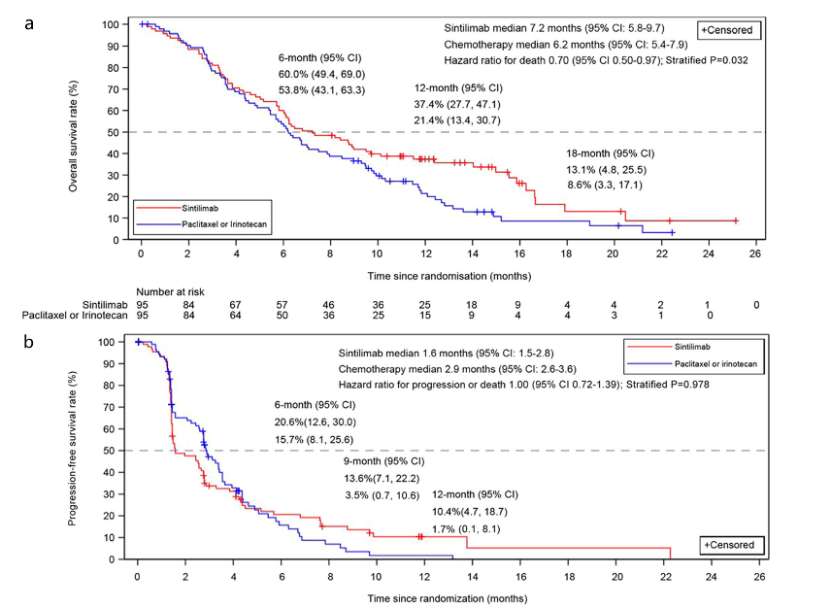 Kaplan-Meier plots of survival (Xu et al., 2022)
Kaplan-Meier plots of survival (Xu et al., 2022)
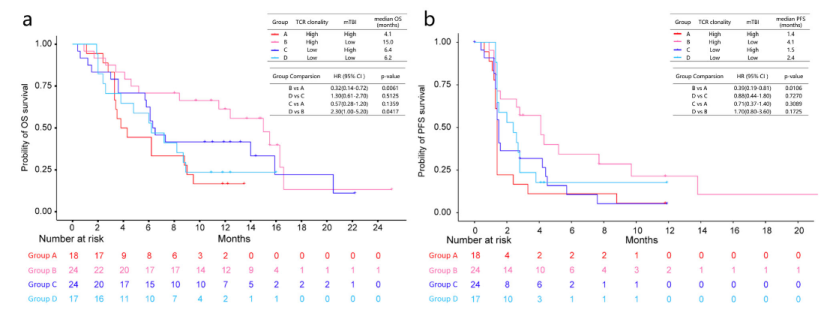 Kaplan-Meier plots of survival in different TCR clonality and mTBI subgroups of the sintilimab group (Xu et al., 2022)
Kaplan-Meier plots of survival in different TCR clonality and mTBI subgroups of the sintilimab group (Xu et al., 2022)
Conclusion
Compared with chemotherapy as the second-line treatment for patients with advanced or metastatic ESCC, the monotherapy of sindilizumab significantly prolongs the survival time and is safe. The NLR <3 at the 6th week after treatment and the combination of high TCR clonality and low mTBI may be effective biomarkers to predict the improvement of OS and PFS in ESCC patients treated with syndesimab.
Take the Next Step: Explore Related Services
Learn More
Background
The selection of drugs based on genomic data has made achievements in the early research of personalized and targeted therapy, and some targeted drugs have been used in ESCC. However, only a small number of patients benefit from these targeted therapies for a long time, which raises the question whether intra-tumor heterogeneity (ITH) or tumor immune microenvironment, such as tumor infiltrating lymphocytes and T cell receptors (TCR), are the reasons for the differences. Therefore, it is necessary to identify new targets and evaluate their spatial heterogeneity before making decisions.
Sample
Multi-regional tumor tissues, normal tissues and blood samples from 39 patients with esophageal squamous cell carcinoma.
Methods
TCR sequencing related results
In patients, the changes of TCR pool were observed, including T cell cloning, high frequency cloning and V-J gene pairing diversity. There are few shared T cell clones in primary tumor samples, and they show great diversity in different patients.
Compared with normal tissue and tumor tissue, TCR diversity in blood is higher, but there is no difference between normal tissue and tumor tissue. Compared with blood and normal tissues, the number of high-frequency clones (> 0.1%) of TRA and TRB in primary tumors is higher, which may be due to the appearance of new antigens.
Jaccard index was used to quantify the similarity and overlap of T cell banks among normal, tumor tissues and lymph node metastasis. It was found that the relationship between primary tumor samples was the closest, followed by the relationship between primary tumor and lymphatic metastasis.
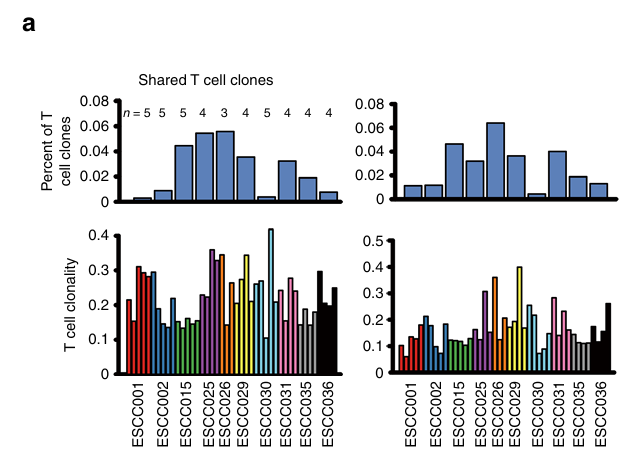 The percentage of shared TCRs in all primary tumor regions (Yan et al., 2019)
The percentage of shared TCRs in all primary tumor regions (Yan et al., 2019)
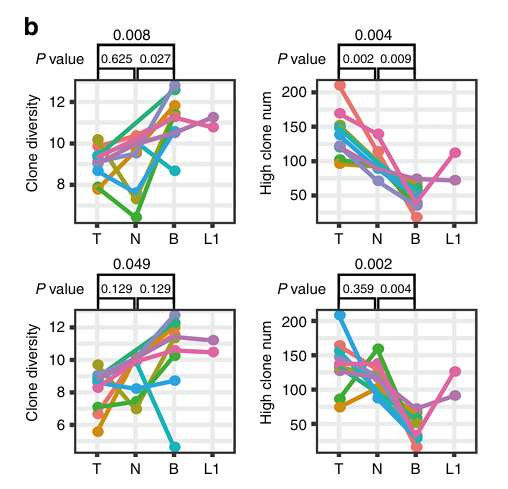 The overall clone diversity and high-frequent clone number of TRA and TRB for four sorts of samples (Yan et al., 2019)
The overall clone diversity and high-frequent clone number of TRA and TRB for four sorts of samples (Yan et al., 2019)
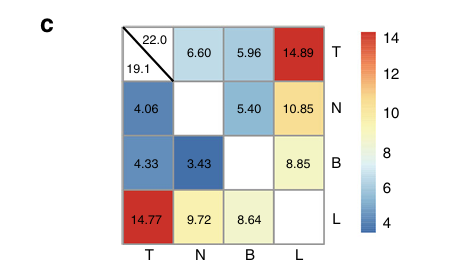 The median overlapped rate between any two types of samples shown by heat map (Yan et al., 2019)
The median overlapped rate between any two types of samples shown by heat map (Yan et al., 2019)
In order to determine the potential biological and clinical relevance related to TCR diversity, the author analyzed the clinical information and new antigens, especially the new branch antigens that are more likely to affect the heterogeneity of TCR library. The high proportion of new branch antigens is related to the short overall survival rate, which is marginal, which may be due to the insufficient sample size.
The total number of new antigens is related to the unique clone number of TRA. The percentage of new branched antigens is negatively correlated with the uniformity of clones and the uniformity of V-J pairs. There is a positive correlation between new branched antigens and high frequency cloning or V-J pairing. These findings suggest that the new branched antigens may be related to the overall diversity of TCR, and some amplified TCR clones may respond to the increase of tumor cell.
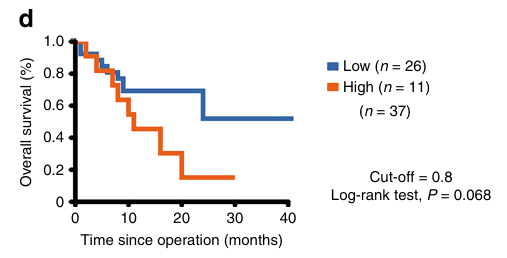 Kaplan-Meier survival curves displaying survival outcomes of ESCCs with distinct neoantigen heterogeneity (Yan et al., 2019)
Kaplan-Meier survival curves displaying survival outcomes of ESCCs with distinct neoantigen heterogeneity (Yan et al., 2019)
 Correlation of T cell repertoire with branch neoantigens (Yan et al., 2019)
Correlation of T cell repertoire with branch neoantigens (Yan et al., 2019)
The author further compares the topological structure of regional tumors between TCR tree and gene tree. In seven patients, compared with other evolutionary branches, regional tumors belonging to the same branch of the gene tree often have more similarities in the TCR tree. These results indicate that the ITH of TCR library in ESCC is largely driven by the genetic heterogeneity of different tumor regions.
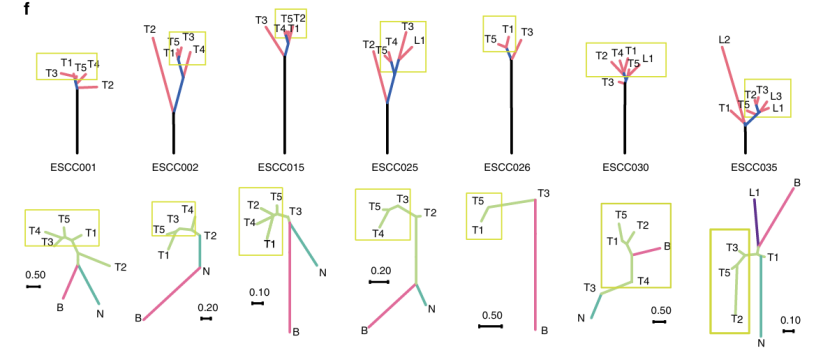 Comparison of TCR tree and genetic tree in seven patients (Yan et al., 2019)
Comparison of TCR tree and genetic tree in seven patients (Yan et al., 2019)
Conclusion
Multi-regional sampling is necessary for future driver gene identification and biomarker prediction. A high proportion of new branch antigens is related to the overall short survival time. In primary tumors, the relationship of spatial TCR library is related to the intratumor heterogeneity (ITH) of genome to some extent, which indicates that ITH derived from genome evolution may have clinical relevance in ESCC by influencing the changes of tumor immune microenvironment.
Take the Next Step: Explore Related Services
Background
PD-1 inhibitor has shown a good application prospect in advanced/metastatic esophageal squamous cell carcinoma (ESCC). However, only a few patients with ESCC have an objective response to PD-1 inhibitor alone. In order to improve the clinical outcome of patient selection, it is urgent to identify effective biomarkers for anti-pd-1 therapy. In view of the fact that checkpoint blockade and TMB-induced new antigens contribute to the anti-tumor immunoreactivity of T cells, T cell atlas is increasingly considered to have great predictive and prognostic value for immunotherapy. The author has conducted related clinical trials before, showing that radiotherapy combined with karizumab has anti-tumor effect on locally advanced ESCC, and its toxicity is controllable.
Sample
CD8+T cells in tumor biopsy tissue and peripheral blood of 19 patients with ESCC
Methods
TCR sequencing related results
Patients with objective response (partial response or complete response) have lower clonality in the tumor at baseline than patients without response (disease stability or progression). Compared with non-responding patients, the TCR diversity of peripheral CD8+ T cells in responding patients was significantly higher after treatment (Shannon index increased, clonality and Simpson index decreased).
There was no correlation between TCR diversity of CD8+T cells in baseline tumor, tumor at the time of treatment or peripheral blood at the time of treatment and patient survival. However, landmark analysis showed that patients with high TCR diversity in CD8+T cells in baseline peripheral blood had better OS and PFS, whereas the high clonality of CD8+ T cells in baseline peripheral blood was related to worse OS and PFS.
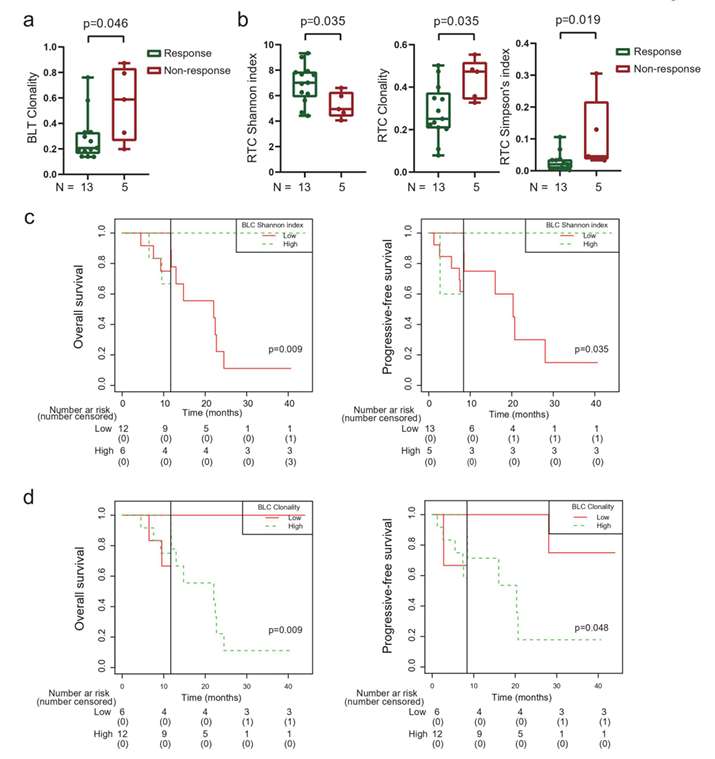 TCR diversity associated with treatment outcome of radiotherapy combined with camrelizumab(Yan et al., 2022)
TCR diversity associated with treatment outcome of radiotherapy combined with camrelizumab(Yan et al., 2022)
Patients with high PD-1+CD4+TILs in baseline tumors have high TCR diversity and low clonality. Similarly, patients with high PD-1+CD8+TILs in baseline tumors also have higher TCR diversity and lower clonality. The correlation between TCR diversity and TMB is weak, which may be due to limited samples.
Patients with more mutations in RTK-RAS pathway have higher TCR clonality (Simpson index increases). The unique TCR clones identified in baseline tumors were divided into two categories. The first category includes "patient-specific" clones, which are only detected in individual patients and are not shared with other patients. The second category includes shared clones found in baseline tumors of at least 2 patients.
The median percentage of shared clones was higher than that of "patient-specific" clones (61.35% vs 38.65%). Among the 5283 unique clones in these baseline tumor samples, the "patient-specific" clones were 2.8 times (71.19% vs. 18.81%) as those shared clones, and the number of TCR clones decreased sharply with the increase of the number of shared patients.
Landmark analysis showed that patients with high "patient-specific" clones in baseline tumors had shorter OS and PFS. These results suggest that TCR diversity in baseline tumors is related to immune environment and heterogeneity.
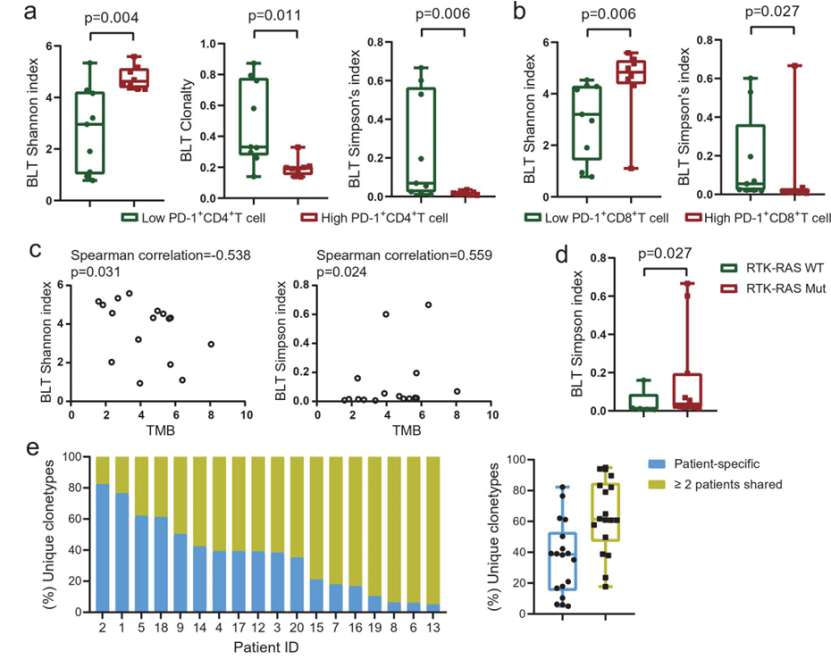 TCR repertoire in baseline tumor tissues associated with tumor microenvironment (Yan et al., 2022)
TCR repertoire in baseline tumor tissues associated with tumor microenvironment (Yan et al., 2022)
Firstly, the TCR library of matched pre-treatment and in-treatment tumors in 15 patients was compared. Compared with baseline, the diversity of TCR in tumor increased significantly during treatment. On the contrary, the clonality in tumor decreased significantly during treatment. Contrary to the change of TCR pool in tumor, the diversity of peripheral CD8+TCR decreased during treatment.
The lymphocyte count of all 19 patients after combined treatment was apoptosis compared with baseline. Before and during the treatment, the persistent clonal type in the tumor was less than 0.1%. Since the TCR richness at the time of treatment only increased in all tumors, these persistent clones were classified as expanded or contracted according to the frequency of higher (expansion) or lower (contraction) in tumors at the time of treatment than in baseline tumors. During the treatment, persistent T cell clones with a median of 46% (ranging from 17% to 83%) were expanded in the tumor.
In tumors during treatment, a higher proportion of these persistent clonal expansions was associated with longer OS and PFS. The authors also evaluated a median of 19 (ranging from 3 to 65)t cell clones, which were identified in the baseline tumor and persisted in peripheral blood during treatment, and 50% (ranging from 18% to 91%) of these clones were amplified in peripheral blood.
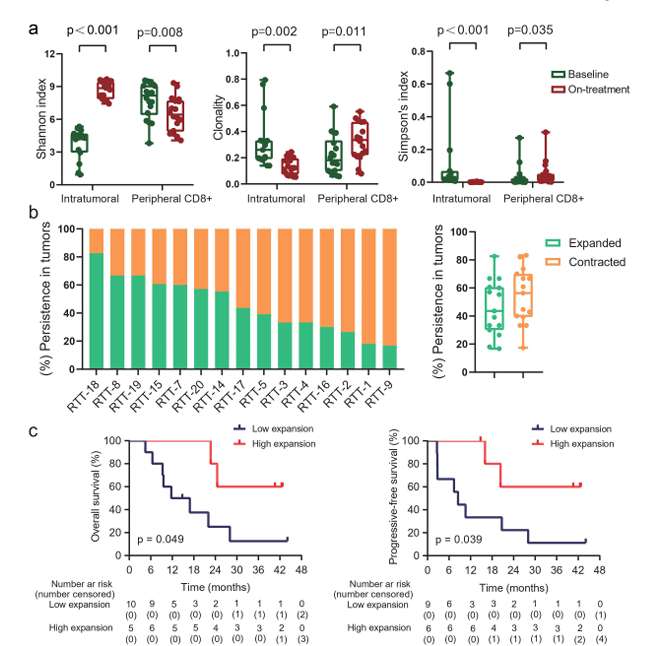 Radiotherapy plus camrelizumab remodel TCR diversity (Yan et al., 2022)
Radiotherapy plus camrelizumab remodel TCR diversity (Yan et al., 2022)
During the treatment, the total frequency of TOP100 clones in tumor decreased, while the total frequency of TOP100 clones in CD8+T cells in peripheral blood increased. Patients with low frequency of TOP100 cloning in CD8+T cells at baseline have longer OS.
Then, the author divides T cell clones into high-frequency clones (cloning frequency ≥0.1%), medium-frequency clones (0.01% to 0.1%) and low-frequency clones (≤0.01%). Compared with baseline tumors, the proportion of high-frequency and medium-frequency clones in all tumors decreased during the treatment period, while the proportion of low-frequency clones increased. During the treatment, the high frequency ratio of CD8+T cells in peripheral blood increased.
Patients with higher low-frequency clones in baseline tumors have better OS. However, patients with high frequency Klonga in the tumor at baseline had worse OS. The authors also analyzed the V-J gene usage profile of TRB before and during treatment. TRBV6-1/TRBJ2-7 pair is the most common in T cells in the baseline tumor, but its frequency decreases, while TRBV20-1/TRBJ2-7 pair has the highest frequency during treatment.
Among the V-J paired fragments found in the baseline tumor, the TRBV20-1/TRBJ1-1 pair is the only fragment whose frequency increased during the treatment. Among CD8+ T cells in peripheral blood during treatment, patients with higher TRBV20-1 level had better OS.
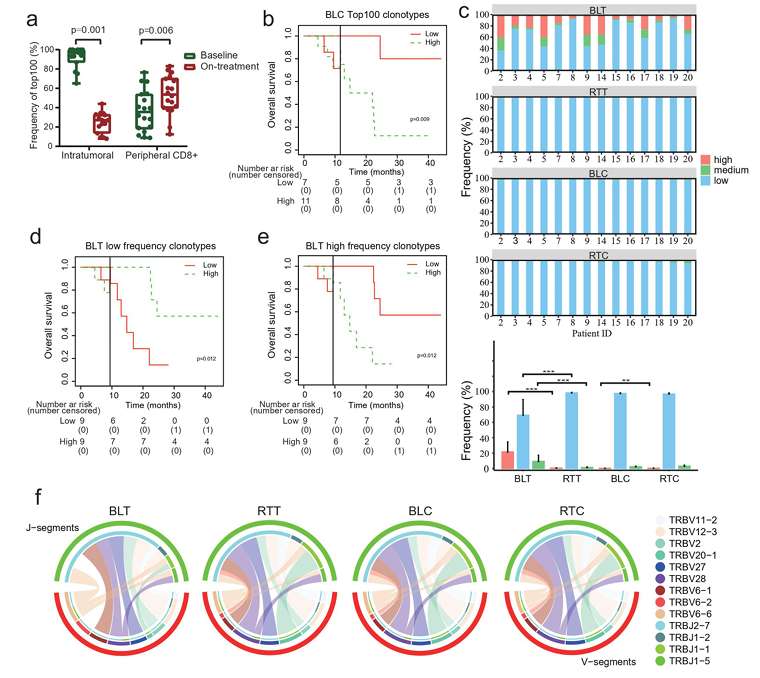 Clonotype redistribution during combination treatment (Yan et al., 2022)
Clonotype redistribution during combination treatment (Yan et al., 2022)
Morisita-Horn (MH) overlap technique was used to evaluate T cell clones shared between tumor tissues and peripheral CD8+T cells. Fourteen patients were included in the analysis. 86%(12/14) patients had increased MH overlap during treatment. A higher MH double overlap (MH overlap at treatment-MH overlap at baseline) indicates an improvement in PFS.
These results indicate the migration between local tumors and systemic blood. The author then focused on the newly shared T cell clone between tumor and peripheral CD8+T cells during the treatment, that is, the T cell clone that was not shared between the two regions at baseline. During the treatment, the new shared clones accounted for 72.63% and 81.88% of the total clones in the tumor and peripheral CD8+T cells, respectively. According to the baseline position of these new shared clones, they were divided into tumor sources that were also detected in baseline tumors, peripheral sources that were also detected in baseline peripheral CD8+T cells, and others that were not detected in both regions at baseline.
Of all the new shared clones, more than 90% are of peripheral origin, a few are of tumor origin, and other sources are not clear in this study. Seven patients (7/14,50%) shared a new shared clonal type with their baseline tumor, accounting for 0.015% of the new shared clonal type among these patients. The median proportion of newly shared clones shared with baseline tumor and baseline peripheral CD8+T cells was 0.002% and 95.78%, respectively. These results showed that T cell clones between tumor and peripheral blood flowed into each other under the combined treatment.
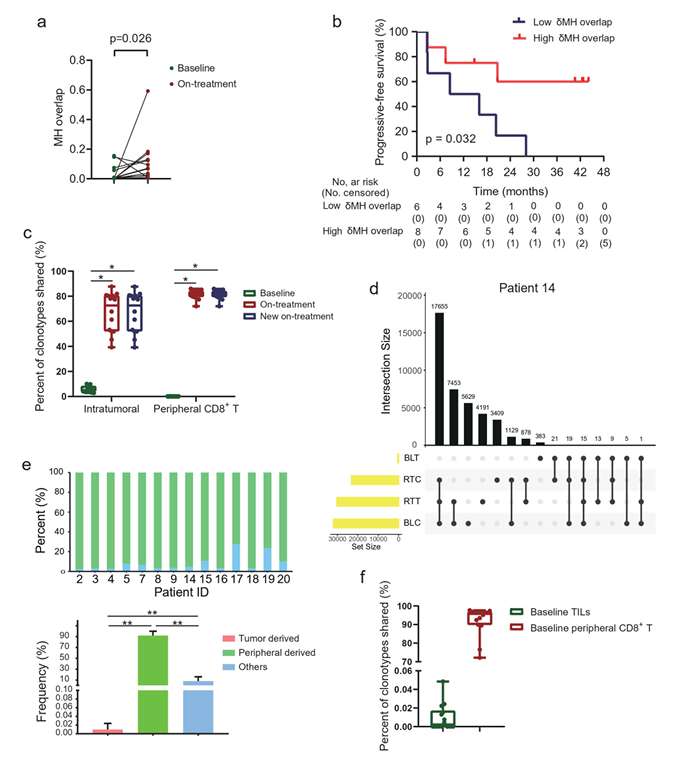 Mutual influx of T-cell clones between tumor and peripheral blood T cells (Yan et al., 2022)
Mutual influx of T-cell clones between tumor and peripheral blood T cells (Yan et al., 2022)
Conclusion
The combination of radiotherapy and karizumab greatly promoted the diversity of TCR in tumor and the mutual inflow of tumor and peripheral blood T cells. TCR bank in baseline tumor is closely related to tumor immune microenvironment, and it is heterogeneous among patients. The high diversity of CD8+T cells in peripheral blood at baseline increased, MH overlap between tumor and CD8+T cells in peripheral blood during treatment and the expansion of T cell clones in persistent tumor are biomarker candidates for predicting the treatment outcome.
References

CD Genomics is transforming biomedical potential into precision insights through seamless sequencing and advanced bioinformatics.
We use cookies to understand how you use our site and to improve the overall user experience. This includes personalizing content and advertising. Read our Privacy Policy